-
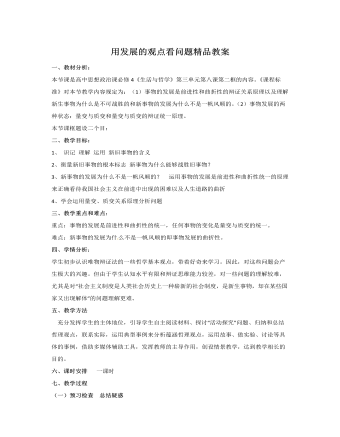
人教版高中政治必修4用发展的观点看问题精品教案
一、教材分析:本节课是高中思想政治课必修4《生活与哲学》第三单元第八课第二框的内容。《课程标准》对本节教学内容规定为:(1)事物的发展是前进性和曲折性的辩证关系原理以及理解新生事物为什么是不可战胜的和新事物的发展为什么不是一帆风顺的。(2)事物发展的两种状态:量变与质变和量变与质变的辩证统一原理。本节课框题设二个目:二、教学目标:1、 识记 理解 运用 新旧事物的含义2、衡量新旧事物的根本标志 新事物为什么能够战胜旧事物?3、新事物的发展为什么不是一帆风顺的? 运用事物的发展是前进性和曲折性统一的原理来正确看待我国社会主义在前进中出现的困难以及人生道路的曲折4、学会运用量变、质变关系原理分析问题三、教学重点和难点:重点:事物的发展是前进性和曲折性的统一,任何事物的变化是量变与质变的统一。难点:新事物的发展为什 么不是一帆风顺的即事物发展的曲折性。
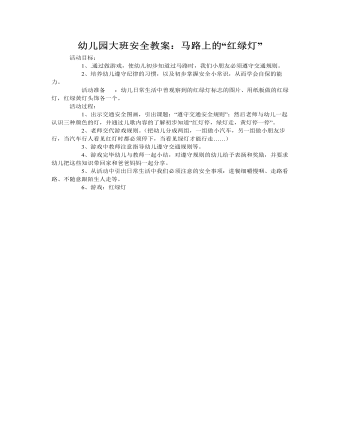
大班安全教案:马路上的“红绿灯”
2、培养幼儿遵守纪律的习惯,以及初步掌握安全小常识,从而学会自保的能力。 活动准备 :幼儿日常生活中曾观察到的红绿灯标志的图片、用纸板做的红绿灯,红绿黄灯头饰各一个。 活动过程: 1、出示交通安全图画,引出课题:“遵守交通安全规则”;然后老师与幼儿一起认识三种颜色的灯,并通过儿歌内容的了解初步知道“红灯停,绿灯走,黄灯停一停”。 2、老师交代游戏规则。(把幼儿分成两组,一组做小汽车,另一组做小朋友步行,当汽车行人看见红灯时都必须停下,当看见绿灯才能行走……)
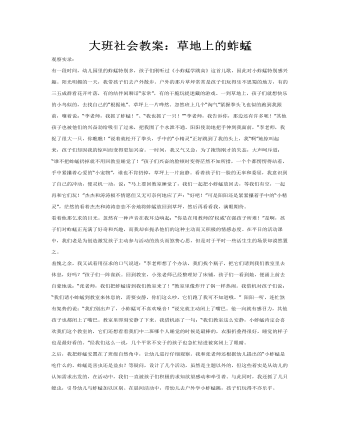
大班社会教案:草地上的蚱蜢
看着他那乞求的目光。忽然有一种声音在我耳边响起:“你是在用教师的‘权威’在强孩子所难!”是啊,孩子们对蚱蜢正充满了好奇和兴趣,而我却在扼杀他们的这种主动而又积极的情感态度。在平日的活动课中,我们老是为创造激发孩子主动参与活动的劲头而煞费心思,但是对于平时一些活生生的场景却漠然置之。 羞愧之余,我又试着用征求的口气说道:“李老师想了个办法,我们找个瓶子,把它们请到我们教室里去休息,好吗?”孩子们一阵雀跃。回到教室,小张老师已经整理好了床铺,孩子们一看到她,便涌上前去自豪地说:“张老师,我们把蚱蜢请到我们教室来了!”教室里像炸开了锅一样热闹。我借机对孩子们说:“我们请小蚱蜢到教室来休息的,需要安静,你们这么吵,它们跑了我可不知道哦。” 阳阳一听,连忙煞有架势的说:“我们别出声了,小蚱蜢可不喜欢噪音!”说完就主动闭上了嘴巴。他一向就有感召力,其他孩子也都闭上了嘴巴。教室里即刻安静了下来。我借机添了一句:“我们教室这么安静,小蚱蜢肯定会喜欢我们这个教室的,它们还想看看我们中二班哪个人睡觉的时候是最棒的,衣服折叠得很好,睡觉的样子也是最好看的。”经我们这么一说,几个平常不安于的孩子也急忙钻进被窝闭上了眼睛。 之后,我把蚱蜢安置在了班级自然角中,让幼儿进行仔细观察。我和张老师还根据幼儿提出的“小蚱蜢是吃什么的、蚱蜢是害虫还是益虫?等疑问,设计了几个活动,虽然是主题以外的,但这些着实是从幼儿的认知需求出发的,在活动中,我们一直被孩子们积极的求知欲望感动和牵引着。与此同时,我还抓了几只蝗虫,引导幼儿与蚱蜢加以区别。在晨间活动中,带幼儿去户外学小蚱蜢跳,孩子们玩得不亦乐乎。
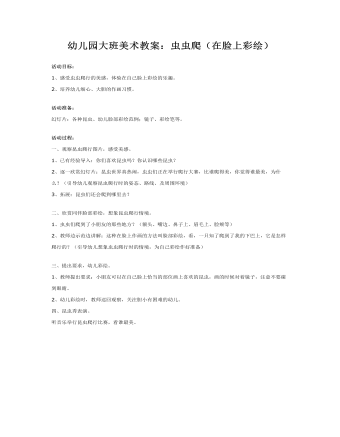
大班美术教案:虫虫爬(在脸上彩绘)
活动准备: 幻灯片:各种昆虫、幼儿脸部彩绘范例;镜子、彩绘笔等。活动过程: 一、观察昆虫爬行图片,感受美感。1、已有经验导入:你们喜欢昆虫吗?你认识哪些昆虫? 2、逐一欣赏幻灯片:昆虫世界真热闹,虫虫们正在举行爬行大赛,比谁爬得美,你觉得谁最美,为什么?(引导幼儿观察昆虫爬行时的姿态、路线、及周围环境) 3、拓展:昆虫们还会爬到哪里去?

大班体育教案:骑上漂亮的自行车
2、培养幼儿互助、友爱、勇敢、合作的品质及能力。 准备 1、幼儿分两组,每组一辆小三轮自行车,用彩色纸装扮一下,看哪组的自行车漂亮。 2、绕障碍骑车:在活动场地上有间隔地放置一些皮球或画一些标志(动物图案等),幼儿排好队,一个接一个地骑车绕过障碍。在每个幼儿掌握了要求、骑车基本熟练后,可开展小组比赛,看哪组骑得好又快。
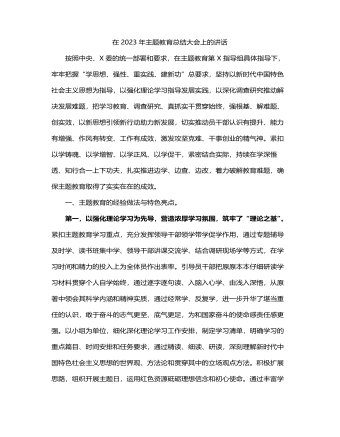
在2023年主题教育总结大会上的讲话
第三,进一步抓好问题整改落实,将主题教育问题整改与推进改革发展有机结合起来,严格对标对表,坚持统筹兼顾、标本兼治,确保整改落实全面到位,同时扎实做好第二批主题教育的谋划准备工作,确保整个主题教育上下联动、有机衔接。深刻认识检视整改是确保主题教育取得实效的关键一环,切实增强做好检视整改工作的政治自觉,坚持边学习、边对照、边检视、边整改,在抓好问题整改上下真功夫、下狠功夫,做到问题不解决不松手、整改不到位不罢休。对检视梳理的问题必须主动认领、自觉对号入座、深刻剖析根源,搞清楚是思想问题还是能力问题,是方法问题还是作风问题,是长期存在的顽瘴痼疾,还是最近才出现的急难杂症,做到真认账、真反思、真整改。从政治上认识、推进和检验整改工作,把人民群众满意不满意作为根本检验标准,增强“等不起、慢不得、坐不住”的紧迫感,把按时完成检视整改作为军令来执行,持续盯住问题不放、严格落实整改措施,确保事事有着落、件件有结果。把制度建设贯穿检视整改全过程,强化制度刚性约束,把整治成效转变为治堵效果,做到既谋当下、又管长远。
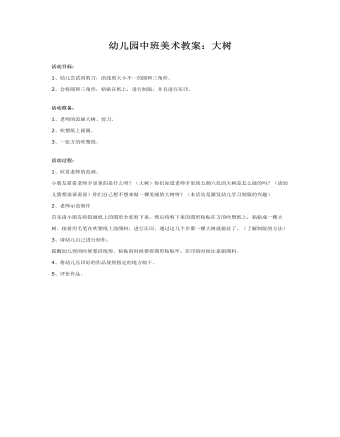
幼儿园中班美术教案:大树
2、会将圆和三角形,粘贴在纸上,进行制版,并且进行压印。活动准备:1、老师的范画大树、剪刀。 2、吹塑纸上画圆。 3、一张方的吹塑纸。活动过程: 1、欣赏老师的范画。 小朋友看看老师手里拿的是什么呀?(大树)你们知道老师手里的五颜六色的大树是怎么做的吗?(请幼儿猜想谈谈说说)你们自己想不想来做一棵美丽的大树呀?(本活动是激发幼儿学习制版的兴趣)
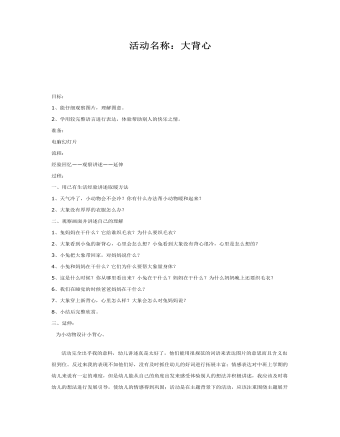
中班语言课件教案:大背心
2、学用较完整语言进行表达,体验帮助别人的快乐之情。 准备: 电脑幻灯片 流程: 经验回忆——观察讲述——延伸 过程: 一、用已有生活经验讲述取暖方法 1、天气冷了,小动物会不会冷?你有什么办法帮小动物暖和起来? 2、大象没有厚厚的衣服怎么办? 二、观察画面并讲述自己的理解 1、兔妈妈在干什么?它给谁织毛衣?为什么要织毛衣? 2、大象看到小兔的新背心,心里会怎么想?小兔看到大象没有背心很冷,心里是怎么想的?
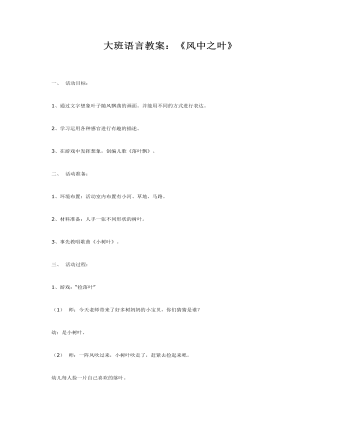
大班语言教案:《风中之叶》
2、学习运用各种感官进行有趣的描述。3、在游戏中发挥想象,创编儿歌《落叶飘》。二、 活动准备:1、环境布置:活动室内布置有小河、草地、马路。2、材料准备:人手一张不同形状的树叶。3、事先教唱歌曲《小树叶》。三、 活动过程:1、游戏:“捡落叶”(1) 师:今天老师带来了好多树妈妈的小宝贝,你们猜猜是谁?幼:是小树叶。(2) 师:一阵风吹过来,小树叶吹走了,赶紧去捡起来吧。幼儿每人捡一片自己喜欢的落叶。(3) 请幼儿描述一下自己的落叶长得什么样?并用形体动作表现出叶子的造型。(长长的、宽宽的、尖尖的、圆圆的、破一个洞的------)
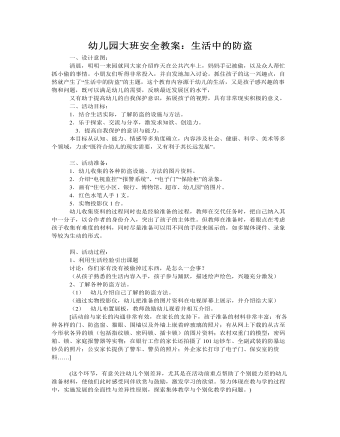
大班安全教案:活中的防盗
二、活动目标: 1.结合生活实际,了解防盗的设施与方法。 2.乐于探索、交流与分享,激发求知欲、创造力。 3.提高自我保护的意识与能力。 本目标从认知、能力、情感等多角度确立,内容涉及社会、健康、科学、美术等多个领域,力求“既符合幼儿的现实需要,又有利于其长远发展”。 三、活动准备: 1.幼儿收集的各种防盗设施、方法的图片资料。 2.介绍“电视监控”“报警系统”、“电子门”“保险柜”的录象。 3.画有“住宅小区、银行、博物馆、超市、幼儿园”的图片。 4.红色水笔人手1支。 5.实物投影仪1台。 幼儿收集资料的过程同时也是经验准备的过程,教师在交代任务时,把自己纳入其中一分子,以合作者的身份介入,突出了孩子的主体性。但教师在准备时,着眼点在考虑孩子收集有难度的材料,同时尽量准备可以用不同的手段来展示的,如多媒体课件、录象等较为生动的形式。
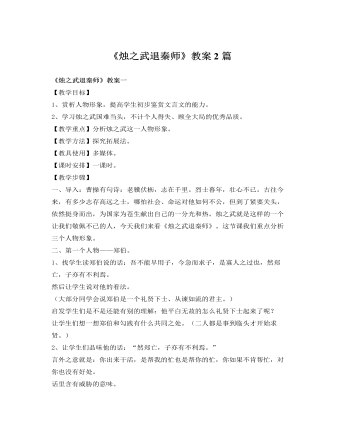
人教版高中语文《烛之武退秦师》教案2篇
【教学目标】1.学习本文精彩的人物语言——说理透辟,善于辞令,以及起伏跌宕,生动活泼的情节。2.掌握文章中出现的古汉语常识,注意多义词在不同语境中的不同意义和用法。3.了解烛之武说服秦伯的方法——善于利用矛盾,采取分化瓦解的方法,认识烛之武机智善辩的外交才能。【教学重点】1.烛之武人物形象的把握。2.波澜起伏,生动活泼的情节。【教学难点】通过学习本课,使学生对《左传》的语言特点有所了解。【教学过程】第一课时课前预习:(1)借助工具书,通读原文。(2)参考有关资料,对《左传》在先秦文学史中的地位及《左传》的语言特色有所了解。(3)初步了解故事情节,特别注意对烛之武这个中心人物的把握。(4)画出自己不理解的问题及难点。
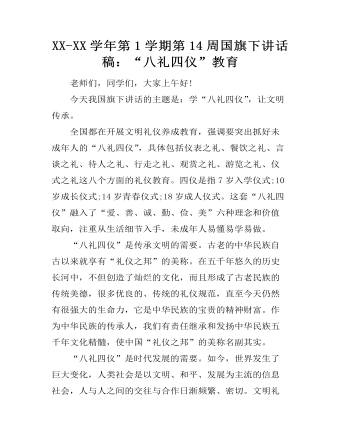
XX-XX学年第1学期第14周国旗下讲话稿:“八礼四仪”教育
老师们,同学们,大家上午好!今天我国旗下讲话的主题是:学“八礼四仪”,让文明传承。全国都在开展文明礼仪养成教育,强调要突出抓好未成年人的“八礼四仪”,具体包括仪表之礼、餐饮之礼、言谈之礼、待人之礼、行走之礼、观赏之礼、游览之礼、仪式之礼这八个方面的礼仪教育。四仪是指7岁入学仪式;10岁成长仪式;14岁青春仪式;18岁成人仪式。这套“八礼四仪”融入了“爱、善、诚、勤、俭、美”六种理念和价值取向,注重从生活细节入手,未成年人易懂易学易做。“八礼四仪”是传承文明的需要。古老的中华民族自古以来就享有“礼仪之邦”的美称。在五千年悠久的历史长河中,不但创造了灿烂的文化,而且形成了古老民族的传统美德,很多优良的、传统的礼仪规范,直至今天仍然有很强大的生命力,它是中华民族的宝贵的精神财富。

《在中亚细亚草原上》教案
教学过程:一、引入首先我们来欣赏一幅油画,它的名字就叫《在中亚细亚草原上》(出示油画)。可能同学们会觉得它不论时间与空间上都离我们很远,那么我们有没有办法让它离欣赏者很近,甚至有身临其境的感觉呢?(提示学生可以从人的视觉与听觉入手)那我们就来给它配乐,在配乐之前我们必须对油画的内容有些了解(出示文字),根据文字提示我们想想它可能出现哪些音乐或声音?设计意图:从画面进入让学生对标题音乐(交响音画)的标题来源有暗示作用,为下节课对标题音乐的总结打下埋伏。二、分段欣赏接下来我们来看看作曲家是如何做的,欣赏以下片段音乐做出连线并说出共有几个主题?(初听)A俄国卫队 音乐1(主题1独奏)B商队渐渐远去 音乐2(对比复调)C安然无虑的当地商队 音乐3(主题2)(教师简单介绍英国管)D二者关系融洽 音乐4(主题1齐奏)E飘过来的俄国曲调 音乐5(主题1渐漫)(教师简单介绍单簧管)问:共有几个主题?1、为何ABE他们同为一主提而表现的音乐内涵却各不相同?(A与E是力度上的变化,而A与B是节奏与力度的变化。)2、你是从哪方面感受出C的安然无虑?(旋律与音色上,可以从英国管是地特定情景下才用的乐器入手进行引导。)3、二者关系融洽你是从哪听出来的呢?(从旋律的层次上,他们用的是对比复调,进行得非常和谐。)
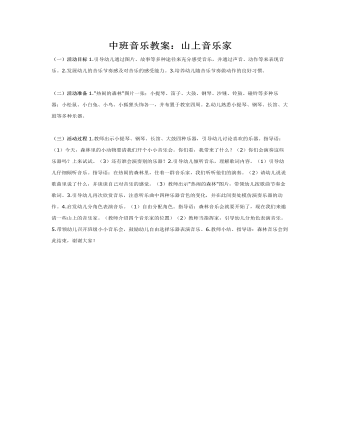
中班音乐教案:山上音乐家
(二)活动准备1."热闹的森林"图片一张;小提琴、笛子、大鼓、钢琴、沙锤、铃鼓、碰铃等多种乐器;小松鼠、小白兔、小鸟、小狐狸头饰各一,并布置于教室四周。2.幼儿熟悉小提琴、钢琴、长笛、大鼓等多种乐器。 (三)活动过程1.教师出示小提琴、钢琴、长笛、大鼓四种乐器,引导幼儿讨论喜欢的乐器。指导语:(1)今天,森林里的小动物要请我们开个小小音乐会。你们看,我带来了什么?(2)你们会演奏这些乐器吗?上来试试。(3)还有谁会演奏别的乐器?2.引导幼儿倾听音乐,理解歌词内容。

主题教育总结常用提纲大全
第一,主题教育是一次思想作风的深刻洗礼,初心传统进一步得到回归。第二,主题教育是一次沉疴积弊的集中清扫,突出问题进一步得到整治。第三,主题教育是一次强化为民服务的生动实践,赤子之情进一步得到提振。第四,主题教育是一次激发创业担当的有利契机,发展层次进一步得到提升。2.第一,必须提领思想、武装思想。第二,必须聚焦问题、由表及里。第三,必须领导带头、以上率下。第四,必须务实求实、认真较真。3.一是抬高政治站位,坚持大事大抓。二是坚持思想领先,狠抓学习教育。三是突出问题导向,深入整改纠治。四是坚持领导带头,发挥表率作用。4.一是立足“早”字抓筹划。二是着眼“活”字抓学习。三是围绕“统”字抓协调。5.一是形势所需。二是任务所系。三是职责所在。四是制度所定。6.一要提升认识。二要积极作为。三要密切协作。

综合教案有用的报纸
一次,我有意将废旧报纸投放于晨间桌面、体育区、语言区、表演区等各区域活动,惊奇的发现,晨间桌面他们会用它来折飞机呀、撕碎片呀、团纸球呀,语言区、表演区他们会像真有回事儿似的学爸爸、奶奶看报呀……在成人眼中不起眼的废旧报纸真的成了孩子们的宝贝。经过多次仔细观察,我发现孩子们虽然兴趣浓厚,可对报纸的玩法、利用性还是存在着局限性。新《纲要》中指出:幼儿是教育活动的积极参与者而非被动接受者,活动内容必须与幼儿兴趣、需要及接受能力相吻合。我想,作为教师,应根据幼儿的兴趣、需要和原有经验,引导幼儿走向最近发展区。由此产生了中班综合活动——《有用的报纸》。开展这一活动,孩子们要有一定的基础。我班幼儿已有折、剪、团等用废旧报纸制作的经验。这一活动适合于中班下学期的小朋友。活动设计:一、活动目标1、帮助幼儿理解故事内容,增强爱惜报纸、保护环境的意识2、了解废旧报纸的再可利用性,能想方设法利用废旧报纸,对报纸制作产生兴趣二、重点、难点1、故事内容以及对故事中报纸不同情绪的感知2、想方设法再利用废旧报纸及用旧报纸制作三、活动准备1、事先排练四位大班幼儿担任小小模特儿的角色(身穿报纸服装、头戴报纸头饰,手拿报纸道具,如:纸伞、纸球、纸棒、纸辫子等随乐表演)2、废旧报纸许多,剪刀、胶水、水彩笔、旧图书、白纸、蜡笔、蛋、脏皮鞋等3、轻音乐、故事录音(见后)4、多媒体课件5、事先排练好二段情境表演四、活动过程1、幼儿观看模特儿表演,初步感知旧报纸的用途师:哎呀!小朋友们快看,来了一群小小模特儿,她们身上的衣服多有趣呀!(幼儿观看表演,模特定格)提问:(1)她们身上的衣服是什么做成的呀?(报纸) (2)报纸做的衣服漂亮吗?(漂亮)报纸还做成了些什么呀?(纸球、纸棒、纸辫子、纸伞、纸扇子等)

新人教版高中英语必修3Unit 1 Festivals and celebrations-Discovering Useful Structure教学设计
4.That was an experience that frightened everyone. →That was _____________________. 答案:1. taking 2. being discussed 3. in the reading room 4. a frightening experienceStep 6 The meaning and function of V-ing as the predicative动词-ing形式作表语,它通常位于系动词后面,用以说明主语“是什么”或“怎么样”一种表示主语的特质、特征和状态, 其作用相当于形容词; 另一种具体说明主语的内容, 即主语等同于表语, 两者可互换。The music they are playing sounds so exciting. 他们演奏的音乐听起来令人激动。The result is disappointing. 结果令人失望。Our job is playing all kinds of music. 我们的工作就是演奏各种音乐。Seeing is believing. 眼见为实。Step 7 Practice1. It is ________(amaze) that the boy is able to solve the problem so quickly.2. Buying a car is simply _______(waste) money. 3. Please stop making the noise—it’s getting ________(annoy). 4. complete the passage with the appropriate -ing form.La Tomatina is a festival that takes place in the Spanish town Bunol every August. I think many food festivals are __________ because people are just eating. however, this festival is _________ because people don't actually eat the tomatoes. Instead, they throw them at each other! the number of people ________ part in this tomato fight, can reach up to 20,000, and it is a very __________ fight that lasts for a whole hour. The _______ thing is how clean Bunol is after the tomatoes are washed away after the fight. this is because the juice form tomatoes is really good for making surfaces clean!答案:1. amazing 2. wasting 3. annoying4. boring interesting taking exciting amazing

新人教版高中英语必修3Unit 1 Festivals and Celebrations-Reading and Thinking教学设计
The topic of this part is “Discover the reasons for festivals and celebrations.The Listening & Speaking & Talking part aims at talking about the experiences and feelings or emotions about the festivals and celebrations. This section aims at detecting the reason why the people celebrate the festivals, the time, the places, the types and the way of celebrations. It also explains why some traditions in the old celebrations are disappearing, like the firecrackers in the big cities and some new things are appearing like the prosperity of business or commerce. 1. Students can talk about what festivals they know and the reasons and the way of celebrating them.2. Students should learn the reading skills such as the headline and get the topic sentences, the structures of articles.3. Students can understand the past, the present situation of some festival around the world and why there are some changes about them. 4. Students can have the international awareness about the festivals.1. Students should learn the reading skills such as the headline and get the topic sentences, the structures of articles.2. Students can understand the past, the present situation of some festival around the world and why there are some changes about them.Step 1 Lead in---Small talkWhat festival do you like best ? Why ?I like the Spring Festivals because I can set off the fireworks, receive the lucky money and enjoy the Gala with my families.Step 2 Before reading---Pair workWhy do people celebrate different festivals ?The Spring Festivals is to celebrate the end of winter and the coming of spring and new life.The Mid-autumn Day is to celebrate the harvest and admire the moon.

新人教版高中英语必修3Unit 1 Festivals and Celebrations-Listening &Speaking&Talking教学设计
The theme of this section is “Talk about festival activities and festival experiences”.Festival and holiday is a relaxing and interesting topic for students. This part talks about the topic from the daily life of students’. In the part A ---Listening and Speaking, there are three conversations among different speakers from three countries(Japan, Rio and China), where the speakers are participating in or going to participate in the festivals and celebrations. So listening for the relationship among them is a fundamental task. Actually, with the globalization and more international communication, it is normal for Chinese or foreigners to witness different festivals and celebrations in or out of China. In the Conversation 1, a foreign reporter is interviewing a Japanese young girl who just had participated in the ceremony of the Coming-of-Age Day on the street and asking her feeling about the ceremony and the afterwards activities. Conversation 2, Chinese girl Li Mei is witnessing the Rio Carnival for the first time, and her friend Carla gives her some advice on the costumes which enables her to match with the carnival to have a good time. Conversation 3, a Chinese guide is showing a group of foreign visitors around the Lantern Festival and introducing the customs of the festival to them. The three conversations have a strong vitality and insert the festival and cultural elements from different countries. So perceiving the festivals and cultures from different countries is the second task. At the same time, the scripts also insert the targeted grammar --- v-ing as attributive and predicative, which students can perceive and experience in a real context and make a road for the further study. That is the third task. In the Part B--- Listening and Talking, the theme is “Talk about festival experience”, which is the common topic in our daily conversations. During the conversation, Song Lin, a Chinese student, asked Canadian friend Max about how to spend Christmas. In the conversation, Song Lin talked about experience and the feelings during the Chinese Spring Festival, during which there are not only some enjoyable things but some unpleasant things. After the listening, perhaps students find there are some similarities between Christmas and the Chinese Spring Festival as there are some differences in the origins and celebrations. For example, people always visit friends and relatives, decorate their houses, have a big dinner together, chat and give presents to each other.

新人教版高中英语必修3Unit 1 Festivals and Celebrations-Reading for writing教学设计二
Step 3 Analyzing article structureActivity 31. Teachers raise questions to guide students to analyze the chapter structure of this diary and think about how to describe the festival experience. (1)What should be included in the opening/body/closing paragraph(s)?(2)How did the writer arrange his/her ideas?(3)What kind of interesting details did the writer describe?(4)How did the writer describe his/her feelings/emotions during the event?2. Students read and compare the three sentence patterns in activity 2. Try to rewrite the first paragraph of the diary with these three sentence patterns. After that, students exchange corrections with their partners. Such as:●This was my first time spending three days experiencing the Naadam Festival in China’s Inner Mongolia Autonomous Region and it was an enjoyable and exciting experience. ●I'll never forget my experience at the Naadam Festival because it was my first time to watch the exciting Mongolian games of horse racing, wrestling, and archery so closely. ●I'll always remember my first experience at the Naadam Festival in China’s Inner Mongolia Autonomous Region because it was so amazing to spend three days witnessing a grand Mongolian ceremony. Step 4 Accumulation of statementsActivity 41. Ask the students to read the diary again. Look for sentences that express feelings and emotions, especially those with the -ing form and the past participle. Such as:● …horse racing, wrestling, and archery, which are all so exciting to watch. ● some amazing performances● I was surprised to see…● I was a little worried about. . . ● feeling really tiredOther emotional statements:●I absolutely enjoyed the archery, too, but the horse races were my favourite part. ●I'm finally back home now, feeling really tired, but celebrating Naadam with my friend was totally worth it. ●He invited me back for the winter to stay in a traditional Mongolian tent and cat hot pot. I can’t wait!2. In addition to the use of the -ing form and the past participle, the teacher should guide the students in the appreciation of these statements, ask them to memorize them, and encourage them to use them reasonably in writing practice.

